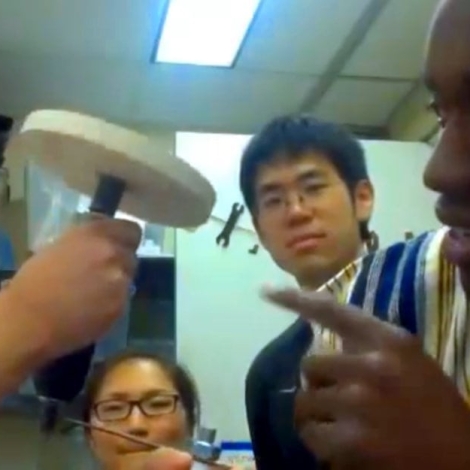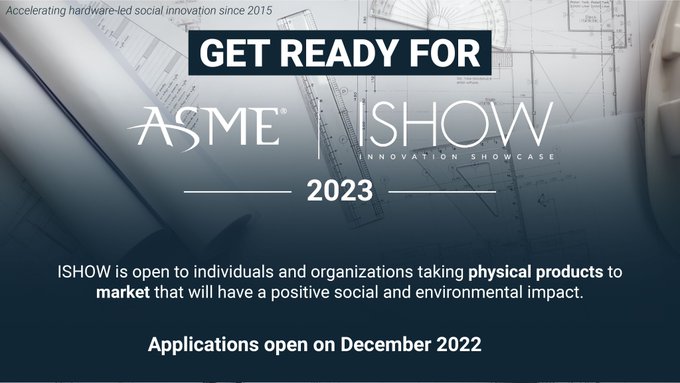Low-budget engineering virtuosos at MIT have transformed a gear box from an electric drill into a hand-cranked centrifuge for clinical blood testing. The student team at MIT’s D-Lab designed the Coriolis hematocrit centrifuge to run without electricity as a durable and low-cost supplement to healthcare in the developing world. Their device featured as one of ten semi-finalists at the American Society of Mechanical Engineers’ Innovation Showcase on June 22nd.
The Coriolis was side by side with devices such as a Brigham Young University team’s Shot Coach, a tracking device for basketball players; a Harvard team’s Theratech, a disposable electronic drug delivery patch; a University of Michigan teams’ TurtleShell, a smart phone case with retractable ear buds; and others. The Coriolis stands out as an appropriate technology that could make a difference in underserved communities.

“Our prototype is still work-in-progress, so I’m afraid that there is no sleek, nice-looking design yet. It’s essentially “bootstrapped” – a wooden box right now,” MIT engineer Kevin Kung says. Photo courtesy of Kevin Kung
Coriolis on YouTube:
The team introduces their prototype on this YouTube video that we recommend: Coriolis hematocrit centrifuge.
A talk with the designer
We asked Kevin Kung on the Coriolis’ design team about how it’s made and when it might debut in a clinic.
E4C: Have you seen a medical center that could use a device like yours?
KK: We have visited clinics in the developing world, such as in Uganda and Kenya, and seen firsthand how centrifuges are used. Before we started our design process, we had the chance to interact extensively with Dr. Awojobi. [Editor’s note: Dr. Oluyombo Awojobi heads a clinic in Eruwa, in rural Nigeria, and Coriolis team met him through contacts with D-Lab.]
Even though we still have not visited his clinic, the various conversations we had with him really helped us identify the specific design goals that we needed to achieve with our product. Essentially, throughout the whole design process, Dr. Awojobi was our customer persona.

Photos courtesy of Kevin Kung
E4C: What prompted the idea to pillage a drill like that? (Looks like a good idea, by the way…)
KK: We went through various iterations in seeking to build something smaller and self-containable in a box. We started by building a bicycle-powered centrifuge much like what Dr. Awojobi was using so that we could get a sense of how it worked.
Essentially, we were looking for something that would achieve a great gear reduction in a small space. After some time brainstorming, the idea of a planetary gear set as a compact way to achieve gear reduction came about, and we started looking for all devices that had such a gear set. Our workshop happened to have many such drills, so that was what we used. Drills happened to be a good choice because it is also ubiquitous in most parts of the developing world.

Photos courtesy of Kevin Kung
E4C: Do you envision this as something like a construction manual that you would distribute to clinics, or do you have a commercial product in mind as the end result?
KK: We don’t think we will have a good answer until we really hit the field and try out a thing or two and learn about what works and what does not work. Initially, given that this is a medical device that spins biohazardous materials rapidly, some minimum precision, safety, and quality control are desired, so we will mostly likely start by tightly controlling the design process and manufacturing the product ourselves at a small scale so that chance for accidents and injuries are minimized as we are iterating the design. However, after the design is iterated and improved, in order to achieve a greater dissemination scale in diverse contexts, it is a possibility to send an instruction manual to communities to “hack” their own centrifuges.

Photos courtesy of Kevin Kung
E4C: And finally, what kind of feedback did you receive at iShow?
KK: We were humbled to see the various other products, many of which are in a much more advanced stage than ours. These are products where students have spent several years designing and reiterating. This really reminds us that there is still a long way to go for our product to be commercializable. However, during iShow, we learned about the importance of generating a business plan for commercialization early, even when the design is still preliminary. After all, how we plan to go to market will have a tangible effect on how we design the product!
Related resources
A repurposed salad spinner could save lives at rural clinics
A blood centrifuge made from a modified kitchen appliance could be a low-cost and energy-efficient way to diagnose anemia in impoverished areas.
Providing telemedicine to Peru’s medical outposts
An inside look at the IEEE Humanitarian Technology Challenge

